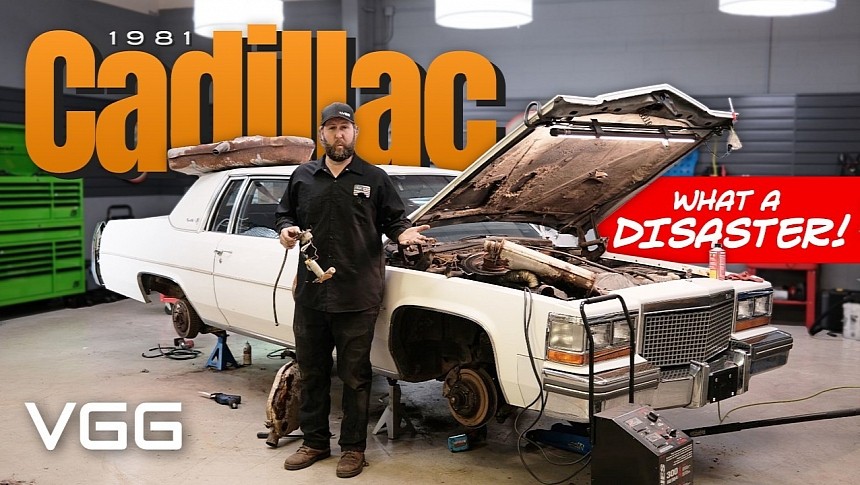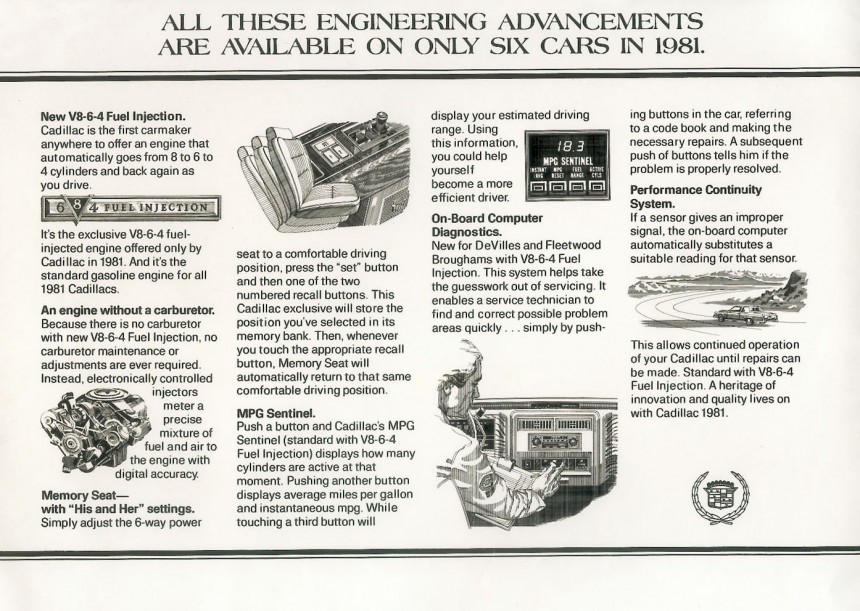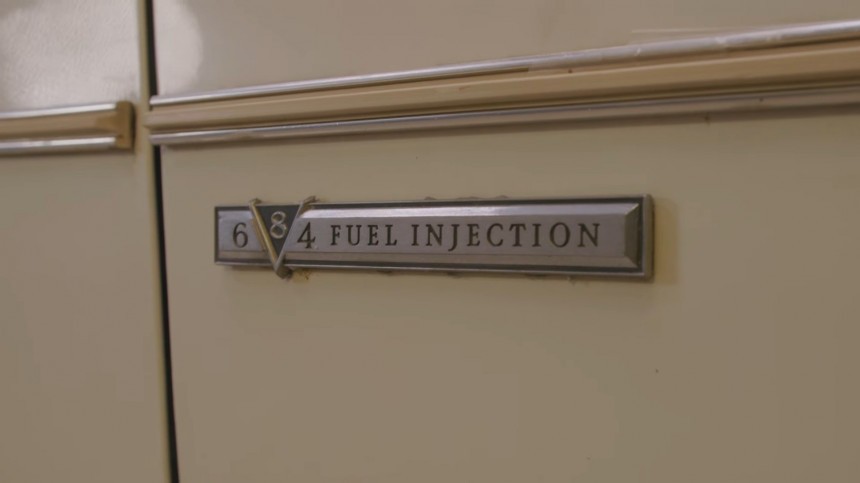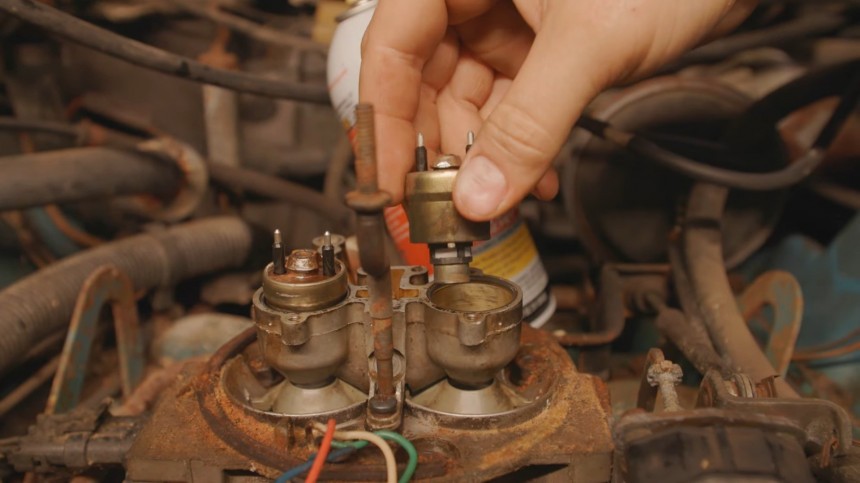The Saturn V rocket that put Man on the Moon was – and still is – the most complex (and complicated) vehicle ever devised and one of the most intricate man-made objects ever. The Cadillac V8-6-4 variable displacement motor of 1981 is a close second. Owners of the car might argue otherwise since the rocket didn’t break down and was actually excellent at what it was designed to do. And if, in this day and age, you have missed feelings about computerized cars, put the blame on General Motors and their infamous Cadillac.
How many times have you seen Derek Bieri from the Vice Grip Garage YouTube channel lose the wrenching challenge? He sure knows how to resuscitate old motors (and transmissions, steerings, suspensions, brakes, and the other conveniences that make a car perform like… well, a car). When it comes to all things mechanical, he is a professor emeritus at the YouTube Academy of Pistons.
However, his latest rescue attempt ended up face-down, not by his wrongdoings. True to his car-reviving habits, he bought a 1981 Cadillac Coupe DeVille sight unseen and then put it back on the road. And it wasn’t even a derelict pile of rust with pistons and wheels still attached – it’s a decent-condition automobile with a good life.
Corrosion-free, dent-free, abuse-free, and peace-of-mind-free, his Cadillac has the infamous V8-6-4 fuel-injected engine only offered in 1981. The General Motors luxury division’s top brass were so confident about their technological prowess and infallibility that they made it the standard motor in all Caddies of that year.
And that’s where General Motors recorded one of the most bitter defeats human ingenuity ever experienced. The triumph of technology over intelligence was so overwhelming that the much-lauded computerized wonder was unceremoniously swept under the rug that same year. And Derek Bieri can testify to that after having been defeated by the ancient computers of 42 years ago.
Sure, Cadillac praised it as a three-engines-in-one engineering breakthrough, a 368-cubic-inch V8 that could shut off two or four cylinders under certain conditions. Sounds familiar, doesn’t it? Sure, today’s (outdated) combustion engines regularly have this option, thanks to a degree of sophistication that fends off any attempts at self-wrenching by the regular gearhead. But in 1981, computer technology wasn’t omnipresent.
The 6.0-liter Cadillac engine was governed by a sophisticated array of sensors and solid-state microcircuits that could handle 300,000 calculations per second - at least, that's what the GM division claimed. This processing power was enough to perfectly synchronize the solenoids installed atop the rocker arms of two pairs of cylinders and effectively hold the valves shut. The brochure of the time (see it in the gallery) wasn't particularly rich in details, but it promised a motoring revolution, in theory.
‘In theory’ is the crucial element here because practice didn’t make perfect; it made it worse. The actual operation of the Modulated Displacement (the name GM gave to its computer agony) was magnificent - at annoying customers who expected their Cadillacs to drive like 15,000+ bucks (the base MSRP for the cheapest model). The electronic control unit was supposed to cut off two or four cylinders when it detected a light load on the big V8, thus saving fuel. Under heavy acceleration, the engine would automatically return to its full eight-cylinder status.
As it turned out, the variables were too much for the computer to handle, and switching from 8 to 6 to 4 and anywhere in between was a headache. Customers rushed to dealerships complaining about their car’s behavior, so Cadillac discontinued the engine at the end of 1981, after one year. The technology was too young to be effective despite being touted as derived from the U.S. space program.
Unfortunately – for Cadillac – the cars didn’t have to go into outer space but drive at ground level, and that was, apparently, far more challenging than putting a space shuttle into orbit. (in 1981, Columbia was the first Space Transportation System to orbit the Earth 37 times before returning). With all that uncharted territory to explore, Cadillac ventured too far and lost the bet. The cars jerked, bucked, stalled, made un-Cadillac noises, and acted below their luxury auras.
Cadillac addressed this problem with a good old-fashioned, reliable, analog, and efficient workaround: it deactivated the system altogether, allowing the V8 to work full-time like a V8. From a mechanical standpoint, the 368-cubic-inch motor was just as great as any other Cadillac iconic V8s before it. To defend its name, General Motors sent letters to owners of the V8-6-4 cars to reassure them about the motor’s qualities. Attached to said letters were Engine Value Protection plans. That was corporate lingo for a five-year or 50,000-mile warranty applicable to any number of a car’s owners, not just the original buyer.
Despite the PR efforts and promises of a bright future of motoring, the too-good-to-be-true computerized system was axed mercilessly. General Motors wasn’t in a position to bargain in the early 80s. With the energy crunch in full swing and a massive wave of Japanese and European threats to the venerable paradigm of American motoring (‘big is good, bigger is great’), GM desperately needed to act fast.
Alongside the overly complicated computers, 1981 also introduced the infamous 350-V8 Diesel as the run-off-the-mill powerplant on the Seville. At the time, it was the only automobile in the world that offered a diesel V8 as standard. Yeah, it wasn’t the greatest of years for General Motors, which managed to shove both its feet in its mouth.
The variable displacement proved a flop, and the diesel story only managed to scare customers away from any such American-made passenger car for a good two decades. To add to the misery, 1981 was the launch year of Mercedes’ turbodiesel inline-five, the 300D, as an option for personal automobiles. The Germans made the best of it, establishing the famous high-quality engineering reputation that endures to this day.
However, his latest rescue attempt ended up face-down, not by his wrongdoings. True to his car-reviving habits, he bought a 1981 Cadillac Coupe DeVille sight unseen and then put it back on the road. And it wasn’t even a derelict pile of rust with pistons and wheels still attached – it’s a decent-condition automobile with a good life.
Corrosion-free, dent-free, abuse-free, and peace-of-mind-free, his Cadillac has the infamous V8-6-4 fuel-injected engine only offered in 1981. The General Motors luxury division’s top brass were so confident about their technological prowess and infallibility that they made it the standard motor in all Caddies of that year.
Sure, Cadillac praised it as a three-engines-in-one engineering breakthrough, a 368-cubic-inch V8 that could shut off two or four cylinders under certain conditions. Sounds familiar, doesn’t it? Sure, today’s (outdated) combustion engines regularly have this option, thanks to a degree of sophistication that fends off any attempts at self-wrenching by the regular gearhead. But in 1981, computer technology wasn’t omnipresent.
The 6.0-liter Cadillac engine was governed by a sophisticated array of sensors and solid-state microcircuits that could handle 300,000 calculations per second - at least, that's what the GM division claimed. This processing power was enough to perfectly synchronize the solenoids installed atop the rocker arms of two pairs of cylinders and effectively hold the valves shut. The brochure of the time (see it in the gallery) wasn't particularly rich in details, but it promised a motoring revolution, in theory.
As it turned out, the variables were too much for the computer to handle, and switching from 8 to 6 to 4 and anywhere in between was a headache. Customers rushed to dealerships complaining about their car’s behavior, so Cadillac discontinued the engine at the end of 1981, after one year. The technology was too young to be effective despite being touted as derived from the U.S. space program.
Unfortunately – for Cadillac – the cars didn’t have to go into outer space but drive at ground level, and that was, apparently, far more challenging than putting a space shuttle into orbit. (in 1981, Columbia was the first Space Transportation System to orbit the Earth 37 times before returning). With all that uncharted territory to explore, Cadillac ventured too far and lost the bet. The cars jerked, bucked, stalled, made un-Cadillac noises, and acted below their luxury auras.
Despite the PR efforts and promises of a bright future of motoring, the too-good-to-be-true computerized system was axed mercilessly. General Motors wasn’t in a position to bargain in the early 80s. With the energy crunch in full swing and a massive wave of Japanese and European threats to the venerable paradigm of American motoring (‘big is good, bigger is great’), GM desperately needed to act fast.
Alongside the overly complicated computers, 1981 also introduced the infamous 350-V8 Diesel as the run-off-the-mill powerplant on the Seville. At the time, it was the only automobile in the world that offered a diesel V8 as standard. Yeah, it wasn’t the greatest of years for General Motors, which managed to shove both its feet in its mouth.
The variable displacement proved a flop, and the diesel story only managed to scare customers away from any such American-made passenger car for a good two decades. To add to the misery, 1981 was the launch year of Mercedes’ turbodiesel inline-five, the 300D, as an option for personal automobiles. The Germans made the best of it, establishing the famous high-quality engineering reputation that endures to this day.





